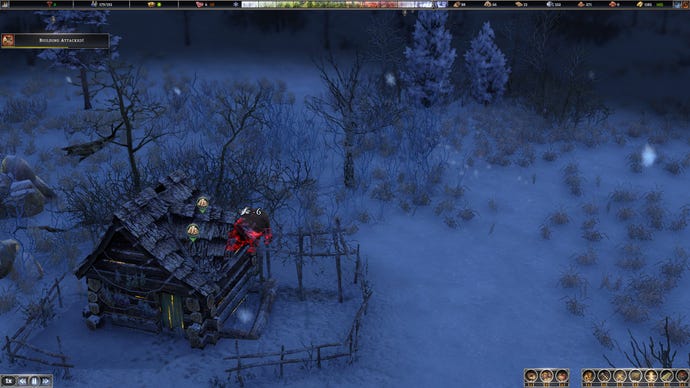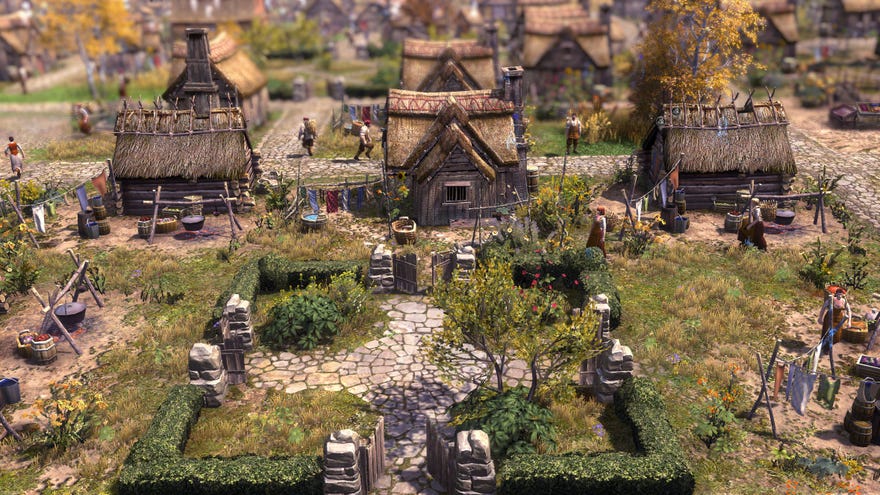Crop rotation is an unexpected joy in town-builder Farthest Frontier
Oh oi'd kill for a brand new combine harvester
Playing settlement-building survival game Farthest Frontier has me planning a lot. I'm planning outposts to mine distant resources. I'm planning road and neighbourhood layouts to optimise movement and happiness. I'm planning defences to fend off bandits. But most of my thought is going on farming, planning my crop rotations to optimise fertility and yields. Finally, I have a use for everything school taught me about the three-field system and the nitrogen cycle.
Made by Crate Entertainment, the studio behind the action-RPG Grim Dawn, Farthest Frontier launched into early access on August 9th. You know the story: striking out on your own with a wagon and a handful of settlers, you found a new town with a handful of shacks on the wild frontier then set about taming it with hunters, foragers, tanners, miners, cobblers, soldiers, and so on up the tech tree. It is quite a splendid virtual ant farm.

Every item in Farthest Frontier exists as an object in the world. Every apple, every stone, every smoked fish, every pail of water, every basket, every bushel of wheat, every sword, every arrow must at some point be carried by someone, not to mention of course the wood you need to make that arrow, and... it's a lot of logistics. At first, you'll see your little people scurrying around doing all the work themselves. Even just building a hunter's lodge is a complicated process. Once you find a good spot in the woods with plentiful prey, workers will need to fell trees and clear stones to make space, then carry over the materials needed to built the lodge, then take the time to build it, then the newly hired hunter will head out to stock their new home with food and water, and fetch weapons, and I'll not even start explaining the chain to preserve, store, and distribute the hunted meat.
So dig roads to speed movement, cobble them to hasten it further, build storage depots to stash and spread supplies, and build wagons to handle bulk transit. The bigger your settlement, the more hands you'll have helping, and the more you can semi-automate.
I do enjoy when my town ticks along enough that I can sit back and watch my little ant farm buzz with life. Everyone has animations for whatever they're up to, and I enjoy the tilt-shift camera effect kicking in as I zoom in to watch woodsplitters split wood, labourers chop and dig, the night soil collector pushing their cart, the wagon drivers trundling along, people dashing about to collect food and deliver goods, and all the rest—even crops slowly growing.

Farming is my favourite aspect of Farthest Frontier to focus intently on. Hunting and foraging can only feed so many people, and keeping animals takes a huge initial investment, so crops are vital. What delights me is that you don't simply drag a farm into the landscape and watch food roll in, you have to carefully plan your crops for yields and sustainability.
You can plant several different crops in a field across the year, each with different growing periods. Certain crops are vulnerable to frost or heat damage, so pick your seasons them carefully. And different crops work better in different soils, so plant carefully or consider adjusting the soil by adding more clay or sand (once you have mines for those resources, of course). Monoculture will leave you vulnerable to blight, too. But you're not just planning for one year, it's set up for three-year cycles. Farthest Frontier's farming is all about the rotation.

Farm intensively and you'll soon have barren soil producing meagre harvests. Remember your schooling: soil needs time and care to recover. Along with planting crops, you can set farmers to maintain the soil, reducing weeds and stoniness. The biggest help comes from planting clover, which you can't eat but does boost fertility a lot. The nitrogen-fixing crops of beans and peas help fertility a little while still providing food too. And a big kick of fertility can come by spreading compost from the, ah, offerings collected as night soil.
With soil needing time to recover, you'll want to plan not just a crop rotation but a field rotation system to keep food coming. While one field recovers, have others growing, staggering their recuperative years. It is unreasonably pleasing to get a system of fields set up nicely.
Usually my attention in town-builders goes on perfectly building layouts but here I'm thinking more and more about my crop rotations. I trust the town will be fine but what about my flax? I know I've slightly botched my latest settlement's field layouts, and have suffered some crippling blights.

In Farthest Frontier, I do lose interest past a certain point. I enjoy struggling to survive at the start, desperately trying to stockpile resources while carefully managing growth. I like seeing my handful of shacks grow into a hamlet, then a village, and the beginnings of an industrialised town. I like the initial excitement of unlocking new buildings and expanding towards distant valuable resources but the settlement-building early game interests me more than the town-managing game which Farthest Frontier grows into. The escalating raider hordes aren't an interesting challenge either, just a punishing one, and the solutions to them are not fun either. It all starts to drag.
I should be clear that I feel this way about a lot of the survive-o-building genre; I suspect serious builders might feel otherwise. But I've been happy playing the parts I do enjoy up until I don't, then starting over again with the benefit of new knowledge. I think my next settlement will be magnificent. My fields will be perfect.
Farthest Frontier is still in early access. Crate Entertainment had said they expected launch after 8-12 months, so they still have ages to expand and tweak things. They have said expanding the late game is one of their main early access goals. I look forward to seeing the game it grows into.



